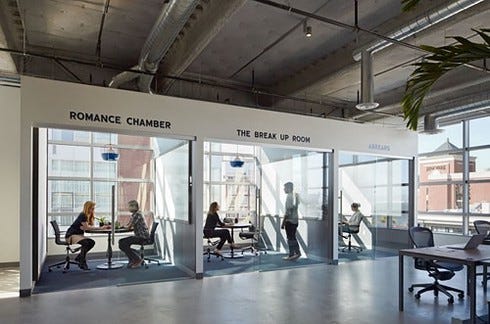The Corporate Culture Wars
It’s hard to compete with free meals and in-house yoga studios, but even founders of early stage start-ups can start thinking about…

It’s hard to compete with free meals and in-house yoga studios, but even founders of early stage start-ups can start thinking about culture.
I recently went to visit a friend for lunch at her new company, a leading organization in the sharing economy, growing at pre-IPO speed. Expecting to meet her in the lobby and head to the company cafeteria for a quick bite, she offered instead to give me a tour of the place before we sat down to eat.
I recall thinking, before my startup was sold I never offered tours of our offices, not out of rudeness but because I never thought there was that much to show. To avoid long commutes we allowed employees in our California offices to work a day or two from home; our offices were perennially quiet. Many days, I didn’t know if folks were working at home or in the office; the view of their “cube” from my desk was always the same. We didn’t brand the building, or even our office door, with our company logo. These expenditures seemed unimportant given our lean funding status.
My friend’s company, on the other hand, had hundreds of millions in funding and had 2,000, versus our 60, global employees. We certainly could not compete with their level of expenditure on office space. But walking through this company’s vision, I did think more about culture and its importance.
This company had an open format. The only space my friend “owned” was an open cubbie — an open wooden locker marked with a piece of scotch tape with her name on it and a hook for her bag — not dissimilar to my kindergardner’s. When I saw it I chuckled. This was the only space that was technically “hers”. People were sitting at the table near her cubbie, and there was no paper or personal effects on the tall, broad Captain’s tables, indicating that employees moved around throughout the day.
I asked her: “Does it bother you, not having a specific place to work?”
She said that, being a natural introvert, it was strange at first not being able to hunker down somewhere, but she’d become accustomed to working wherever a good space presented itself.
In some areas the office seemed like a museum. My friend stopped in front of several displays that were like exhibits — recreations of spaces to inspire employees of the company’s mission. And there were pop-up food stations. No two were alike.
I imagine that meant that every day in that office was a different adventure, which aligned almost exactly with the mission of her company.
For years I’d treated my office as stopping place, purely functional, but this place was built to inspire. As a co-founder I marveled at how these co-founders put thought into culture; both of our companies had it, but this one’s was much more deliberate.
Over lunch, I ate my handmade avocado ice cream and thought, “Hmmm maybe next time…”
Culture is something that’s relatively easy to infuse into your team when you have a handful of employees, but you cannot assume it will naturally germinate from there. If you don’t tend to it, it can’t grow with your company. In my company’s early years we hired people already convinced of our mission — other bloggers who saw the tide of social media on the horizon and wanted to be the first to ride that wave. But as the company got older, and we met with prospective employees who were not, as I lovingly called team members who lived social media strategy, “Crazies,” culture was harder to infuse. And I realize well after the fact we hadn’t fully defined it for everyone.
Sally Helgesen illustrates the need for defining workplace culture through the metaphor of the Broken Windows Theory, a concept meant to explain why urban areas that cleaned up experienced a decrease in crime.
What does all this have to do with corporate culture? After all, graffiti is hardly a scourge in the Fortune 500. When people in the corporate world have a problem with “broken Windows,” they call tech support. But in my view, the lessons learned from this shift in focus in law enforcement do have potential relevance for companies today. After all, broken windows was primarily a cultural program, aimed at changing attitudes about what the community would tolerate, what was OK.…
The broken windows perspective suggests that the kind of lapses that have become familiar in our post-Enron world — bankers rigging a key interest rate, a mining company allegedly sacrificing safety for the sake of increased production — might be anticipated and prevented if organizations paid closer attention to the kind of minor yet problematic infractions that are tolerated in so many no-guts-no-glory cultures.
In my company’s case, I had no concerns about Enron-like conduct, but I wanted a means for others who weren’t coming in from the ground floor to understand our purpose and their role in helping us to meet that purpose.
It made me wonder, is culture only something for those who raise $100 million vs 1 million? How can smaller, fledgling companies clean up its streets, or make sure that the city doesn’t experience any degradation in the first place? In our early days we relied on our reputation as an early mover and definer of our space. But later, how to you infuse culture, and let others take what you started and define it for later hires?
The early passion of the first 5, 10, 100 employees sustains only for so long. What will happen when times get tough? When you are not the darling of your industry? When your chances at IPO or major exit status are taking longer than expected? When your runway is short? You need culture to survive.
Even if you cannot afford fancy windows there has to be some work done on the neighborhood. You can still define your neighborhood. There are some ways that I think culture can be addressed early and effectively.
1. Understand that freebies do not equate to culture. Don’t get me wrong: I appreciated the free lunch and snacks at my friend’s company, and I would appreciate them even more as an employee, but free food does not a culture make. Free food is a perk, a tactic for competing for talent (and table stakes in the case of high-growth tech companies in Silicon Valley). Where free food starts to cross over into culture is in the kind of food (All-organic? Addresses all dietary restrictions?), or makes payment an optional donation.
Twitter, for example, designates one food station in its cafeteria as a paid option, and all of those proceeds from that station are donated to charity.
In some cases freebies, or lack of them, defines culture. Anyone in media sales knows they are expected to wine and dine clients, and they also know that if they are attempting to take out an executive from Walmart they should not overdo it — those employees are expected to pay for themselves and not accept anything from partners, even free lunch. This is Walmart’s low-price, no-negotiation strategy imprinted across its culture.
Amazon, as we now famously know from the much-debated recent New York Times article, has a culture of non-reimbursement. In this article, a woman shared how she paid for data-entry support out of pocket so that she could finish a project on-time and on-budget. While this can be perceived as indicating a company’s focus on results, I would argue that this indicates even more a company’s culture of mistrust in its employees. They are at-fault if a job is not done efficiently enough in the time and budget allocated.
Being in an alliances role for the last 10 years with a number of consumer brands I also have noticed more and less open cultures. Some, like Apple, I’ve never actually experienced because they are so secretive and self-reliant. Others are like walled gardens, and move their employees continually into different roles and require employees to not share their email addresses with people they don’t work with directly to maintain discretion.
Some, like my company, were open with sharing our contact information, sharing contacts, and making connections to others in the company. After all, we were a social media company. Sure this open door policy often meant there were difficulties managing so much inbound, but our culture was about open sharing and rising all boats. Because of our culture, that’s what we signed up for.
2. Consider the most valuable thing you can provide is knowledge. In a recent piece about what makes companies great, Jack Welch writes:
Great companies demonstrate a real commitment to continuous learning. No lip service. These companies invest in the development of their people through classes, training programs, and off-site experiences, all sending the message that the organization is eager to facilitate a steady path to personal growth.
If you are a leader in some capacity at a company, consider that it’s not how much you spend on teams, but how much you share with them. I realized, after years of extensive traveling for work, that I should have been bringing learnings back to the team who implemented many of the programs we developed for clients. I started to present the same educational talks I provided for clients for our client services team.
Formal training is ideal, but even a non-formal means of education that enables personal development indicates you are willing to invest in your employees. Enabling time off for personal or professional development pursuits shows your commitment. A friend of mine, a company founder and avid socialite, loves to hold events for charity and to celebrate friends’ accomplishments. She’s brought her talent for holding events to her own company, holding a speaker series for her employees, featuring the teachings of other entrepreneurs, business leaders, and guru friends who were promoting their latest book.
3. Assign a culture ambassador. Any co-founder is responsible for a company’s culture, but admittedly the devil is in the details, and I found that I wasn’t always able to follow-through on adequately celebrating company milestones, birthdays, and holidays. Fortunately, being an event and digital company, we had engaged talent in-house who always seemed to remember and celebrate.
One of our senior managers was determined to keep her team engaged and often held barbecues at her house to reduce team stress and encourage team bonding. I’m forever grateful to her for this, though we needed to enable this for everyone, on every team. We empowered our head of events, who always seemed to know when someone had a birthday and knew every venue in the area, to, loop in team members and create special celebrations for employees and the community.
I also recommend having someone — preferably a founder, or at the very least a longer-term employee — sit in on job interviews, even if the hire isn’t directly affecting this person. You need a corporate storyteller, who can share the history, examples of culture in action, and who takes an active role in giving prospective employees a clear view of your culture, and after hire, during formal or informal orientation.
4. Consider your recruiting language. In any employee-facing documents describing your company, suck out the cliché words that tend to connote more negative now than positive.
“Hardworking”: Assume that every successful company has employees who take their work seriously. Consider that it’s more likely your employees need ways to accommodate their lives along with hard work. Consider working hard is less important than working smart. “Smartworking” speaks to a more compelling culture.
“Equal opportunity employer”: Using this phrase, while perhaps part of your company’s legal lexicon, is not enough to show your commitment to diversity. Think of how a prospective employee who is of minority status would view this. She’s not thinking, “I hope they will hire a Latina woman,” she’s thinking, “I hope I will get to achieve as much as I am capable of here.” Consider “Meritocracy” as a way to describe your approach to hiring. And mean it.
“Competitive compensation”: This, essentially means, “We offer health insurance, 2–4 weeks of paid vacation and we will adhere to a comp package matching your years in the workplace and lowball your salary offer by about 15 percent, of which we will negotiate back no more than 10 percent.” I cannot argue with companies’ comp structures, but leading with what more or less cannot be customized to an employee’s skills and potential is missing an opportunity to demonstrate your culture.
Talk about how you address compensation for those who succeed at your company, the learning opportunities at your company, any corporate matching programs for preferred employee causes, flexible workplace policies. These programs often factor in as much or more than salary.
5. Borrow from others’ cultures. It’s OK, most cultures are accumulations of others’ inputs. Sure, you want to have differentiation through culture, but you don’t want to simply make one up if you haven’t fully defined your own priorities. Ask new employees what they liked about previous companies, or about companies they admire. The point is not to be unique as much as it is to be relevant. Evolved companies pull the best experiences and make them their own.








